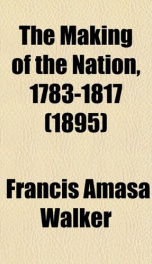the making of the nation 1783 1817

Purchase of this book includes free trial access to www.million-books.com where you can read more than a million books for free. This is an OCR edition with typos. Excerpt from book: CHAPTER III THE CONSTITUTION AS SUBMITTED TO THE PEOPLE A National Form of GovernmentOrganization of CongressEule as to Suffrage in National Elections : The Cause of this found in the varying Rules of the several StatesThe Powers of CongressActs Forbidden to CongressActs Forbidden to the StatesPowers and Duties of the ExecutiveThe Judiciary : Its JurisdictionTrials of all Crimes to be by JuryDefinition of TreasonRelations between Individual States and between the States and the United States : Mutual Faith and Credit, the Rule New States The Territories Guarantee to the States of a Republican Form of GovernmentFuture Amendments to the ConstitutionIntegrity of the Financial Obligations of the ConfederationThe Constitution to be the Supreme Law of the LandNational and State Officers to be bound by Oath to Support the ConstitutionThe Ratification of Nine States sufficient to Establish the New Government. As finally adopted by the Convention of 1787, and submitted to the people, the Constitution established a national legislature, a national executive and a national judiciary, each duly independent of the others. Of the seven Articles which made up the Constitution, the first provided for a Congress to consist of two houses, a Senate and a House of Representatives, following, in this division of the legislative authority, the example of most of the individual States. The House of Representatives was to be composed of members chosen every second year by the people of the several organization States. In order not to impose a uniform of congress. rule of suffrage upon the States, it was provided that those who in each State had the qualifications thererequisite for electors of the more numerous branch of the legislature should be the electors of the rep...
Info about the book
Author:
Series:
Unknown
ASIN:
B003OJZLWQ
Rating:
4/5 (2)Your rating:
0/5
Languge:
English
Users who have this book
Users who want this book
What readers are saying
What do you think? Write your own comment on this book!
write a commentif you like the making of the nation 1783 1817 try:
Do you want to read a book that interests you? It’s EASY!
Create an account and send a request for reading to other users on the Webpage of the book!









